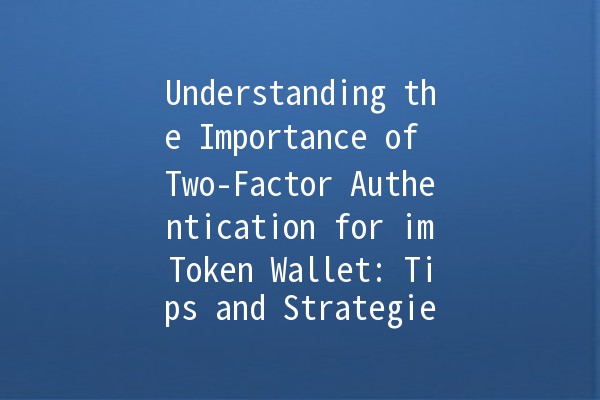In an era where digital transactions require protection against unauthorized access, the implementation of robust security measures is paramount, especially for cryptocurrency wallets like imToken. Twofactor authentication (2FA) has emerged as a key method in securing sensitive information and assets. This article delves into the significance of implementing 2FA for imToken wallet users, providing practical tips and strategies to enhance security and productivity.
Twofactor authentication adds an extra layer of security by requiring not only a password and username but also something that only the user has on them. This could be a physical token, a mobile application, or even biometric data. By employing 2FA, users of the imToken wallet can significantly decrease the likelihood of unauthorized access to their cryptocurrency holdings.

Implementing twofactor authentication is a straightforward process, yet it can be further optimized for better security and user experience. Here are five effective strategies to strengthen your security using imToken wallet's 2FA.
Selecting the right form of 2FA is critical. imToken wallet supports various authentication methods, including:
Authenticator Apps: Using applications like Google Authenticator or Authy generates timesensitive codes that enhance security.
SMS Verification: While better than nothing, SMS codes can be intercepted; hence, it's advisable to prioritize authenticator apps.
Biometric Authentication: If your mobile device supports it, leveraging fingerprint or facial recognition can be an extremely secure option.
Application: For the securest setup, opt for an authenticator app due to its resistance to interception. Install the app, and follow the instructions on imToken to link it to your account for generating your 2FA codes.
Many users link their imToken wallets to other accounts or exchanges. Ensuring that 2FA is enabled for these accounts is essential to provide comprehensive security.
Application: If you have an account on a cryptocurrency exchange or any related financial service, check the security settings and enable 2FA. This provides an additional layer of security, protecting your entire financial ecosystem.
Periodic updates to your authentication practices can significantly enhance security. This includes changing your authentication methods or the devices you're using for 2FA.
Application: Each time you change devices (e.g., upgrading your phone), ensure to reconfigure your 2FA settings accordingly. For added protection, consider rotating your authentication devices every six months.
Understanding how phishing works and the techniques malicious actors use is crucial. Many breaches occur due to users unknowingly providing their information in response to a phishing attempt.
Application: Familiarize yourself with common signs of phishing emails or messages. Develop a habit of scrutinizing sources before clicking links or entering sensitive information.
In the event of losing access to your authentication method, having a secure backup is vital. This could be a backup code provided during the 2FA setup process or ensuring recovery options are in place.
Application: When you set up 2FA, both Google Authenticator and imToken may provide backup codes. Store these codes in a secure, offline location, such as a safe. This ensures you can regain access even if you lose your primary authentication method.
If you lose access to your authenticator app, use the backup codes provided during the 2FA setup. If you have also lost those, you might need to contact imToken support for recovery options.
Yes, you can. It’s advisable to have more than one method (e.g., an authenticator app and a backup SMS number) for added redundancy in security.
It is advisable to change your passwords regularly, at least every three to six months. For authentication methods, consider reviewing and updating every six months or whenever you change your devices.
While SMSbased 2FA is better than no 2FA at all, it is vulnerable to interception and should not be relied on as the only verification method. Use this in combination with more secure options whenever possible.
Backup codes should be stored in a secure offline environment such as a safe or a locked drawer. Do not store them digitally without encryption as this increases the risk of them being hacked.
Immediately change your password and disable 2FA on your wallet. Contact imToken’s support team as soon as possible to investigate and secure your account.
Implementing and optimizing twofactor authentication on your imToken wallet is essential in today's digital landscape. With the increasing prevalence of cyber threats, employing best practices for financial security can significantly enhance the protection of your assets. By following the practical tips outlined in this article, you can fortify your security, thereby enjoying a safer cryptocurrency management experience.